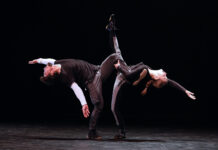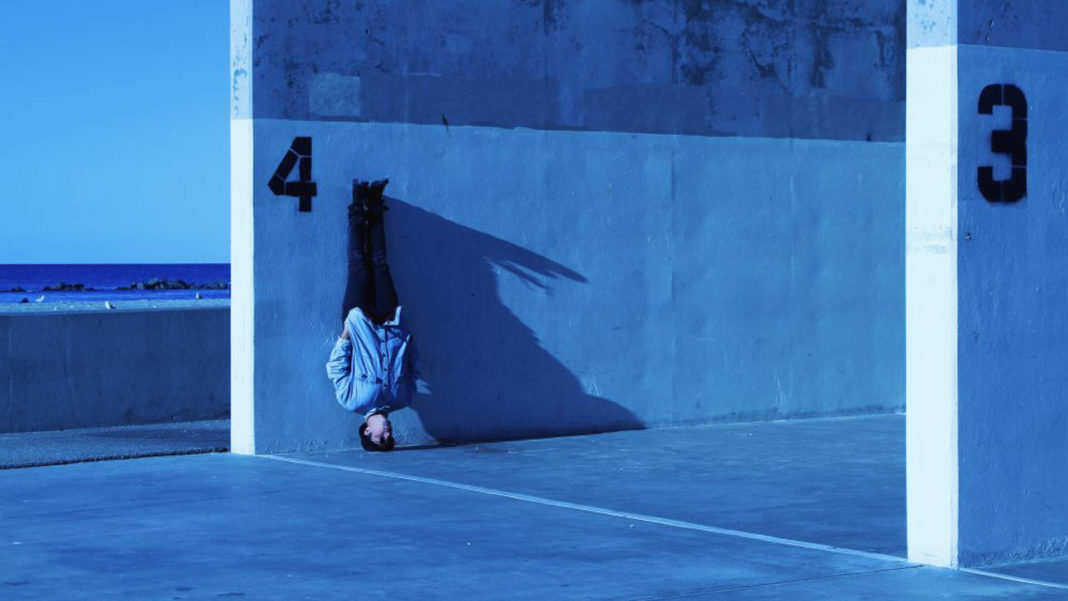“I’m just a little bit ambitious, I guess,” says choreographer/dancer Jacob Jonas after first laughing when asked about presenting five world premieres at his company’s performances this week at the Wallis Annenberg Center for the Performing Arts. All five performances are sold out in the intimate Lovelace Studio Theatre. The company returns to The Wallis for more performances in May. Those performances will be in the Bram Goldsmith Theater.
Jacob Jonas The Company, which was named “Artist in Residence” for 2018/2019 at the Wallis, has received more than its share of positive press coverage. They have variously been referred to as “Best New Dance Force,” one of “12 Standout Companies,” “25 to Watch” and more. Not bad for someone who is all of 26 years old and started the company five years ago.
The pieces being performed this week are Transfer, Make a Toast and Crash (all three choreographed by Jonas) plus Unknown Territories choreographed by Donald Byrd and Cupido choreographed by Omar Román De Jesús.
When I spoke with Jonas by phone last week, we talked about his ambition, balancing acclaim with work and lessons learned.
Why so many world premieres for this engagement?
This was the first summer of our company we weren’t sharing or performing work. We had a lot of time to be in the studio creating. I think it’s a big honor and opportunity to be “Company in Residence” at the Wallis and I wanted to take advantage of the opportunity and not just show repertoire. I wanted to give the audience the honor it deserves and come out full-fledged.
Is there a common theme to be found amongst the five world premieres?
I don’t think there is one. It’s just exciting and diverse. We talked about the theme for the season and it is definitely like equality, inclusion, diversity – this feeling of a global theme. I’m a Jewish artist; one of our guest choreographers is African-American and one is Puerto Rican. There are musicians from Israel, Cuba and all around the world. It really feels like this inclusive program.
With all the attention and acclaim you and your company have received during its first five years, how do you juggle that kind of attention and the expectations that come with it? How does it inspire you rather than inhibit your growth as an artist and as a company?
That’s funny. One of the first reviews I ever got wasn’t very positive from the New York Times. I looked at it as a positive thing. I talked with someone I looked up to and he said “Don’t take anything personally – positively or negatively.” It was really good advice for me at the time.
I think the expectation that I have is with myself. We’ve been consistent with our success with audiences and our reactions from people. I don’t think about the press or any of that stuff going into the show. I want to make the work the best it can be. If I’m content, I’ll follow my instincts and make it the best it can be. There are many artists and organizations that I admire and they’re people making change and that’s what I wake up to in the morning and I want to do that work and at that level.
Can you really make change in the world through dance?
That’s a great question. I think about it three ways. Selfishly I see what dance does for me personally. I have something to look forward to and I’m becoming a better person. I see what it is doing for my dancers, my organization and the audiences we attract. Not just the work onstage, but on Instagram. I get messages all the time that the work inspires. And through education. I just think about the power of the arts. Not just my work, but the exposure to creativity. What the world needs is more funding into the arts and arts education. You’ll se the impact it makes on kids and the future generations.
When you start a company at a young age, what was hardest to learn about the cultural landscape and what are the mistakes you made that informed who you are today?
I think the biggest is not mixing laziness with patience. The ability to be patient is really important in running a company like this. It won’t all happen tomorrow. Having short-term and long-term goals is something I’ve learned. Building a team that is like-minded. There are people who can do what you can do from dance to administration. You can choose the people around you and identify with what your vision is. I think that’s what’s most exciting – to build that team confidently.
Fredrich Nietzsche one said “I would believe only in a God that knows how to dance.” Why do you think dance inspires even as noted a skeptic as Nietzsche?
Because it is just dope. Dance is amazing. I think you can’t really lie. You can’t lie with dancing. You can turn a normal person into a pop star with a good producer. You can find someone on the street and make them an actor. You can’t just be a dancer. It requires so much rigorous training. It’s just such a powerful art form that’s very human and real.
You have talked about being bullied in school for your interest in dance. Five years into having your own company, what would you tell the young boy being bullied if you had the chance to do so?
I don’t know if I would tell him anything different. I think people bullied me because I was dancing. If you wanted to be a ballet dancer anywhere else in the world you are encouraged. But in the States, you say you want to dance and people just judge you for that. It takes a lot of courage, not for me personally, to pursue a life in the arts. Especially because most parents won’t be supportive of it. I think for any artist you have to continue believing in what you want to do, do good work and surround yourself with good people.
Photo and Videos courtesy of JacobJonas.com











